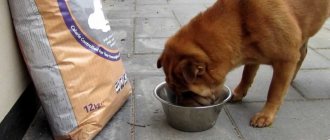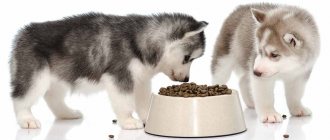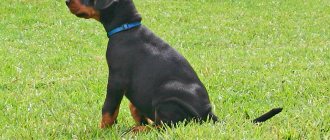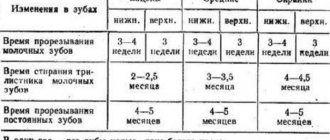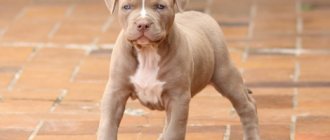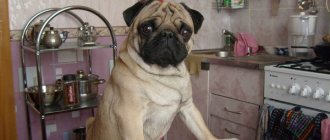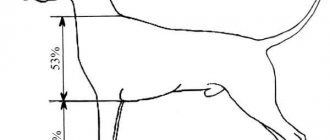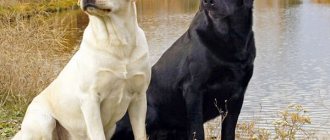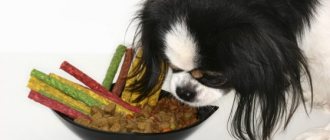Features of feeding a Labrador
The Labrador is an active breed that requires a lot of energy every day. The animal's diet depends on the owner.
The dog is naturally prone to obesity; an incorrectly selected diet will provoke the problem of excess weight within 2 months. In addition to decreased activity and deterioration in appearance, the Labrador will develop diseases of the liver, cardiovascular system, etc.
This is interesting: Features of keeping a Labrador in an apartment
The nutrition of an adult dog must be balanced, with sufficient amounts of proteins, carbohydrates, fats, vitamins and minerals.
What to look for when choosing food
- On the composition of nutrients. They are listed in descending order;
- High-quality food must contain probiotics, fruits, vegetables and various microelements;
- To the country of the manufacturer - sometimes the license for the production of your favorite food may be issued to other manufacturers. And they can quietly replace quality ingredients with waste;
- For preservatives in the composition - in the West they have not used sodium nitrite, ethoxyvin, hydraxyanisole butylate and hydroxytoluene butylate for a long time. Instead, vitamins E and C are added. If you find chemical components in the food, it is better to put it aside and look further. The fact is that synthetic additives can cause cancer and all sorts of abnormalities in the functioning of internal organs in dogs. Just imagine that your pet will be forced to swallow this chemical every day;
- In addition to preservatives, the composition should not contain dyes, which also have a carcinogenic effect;
- The food packaging should describe in great detail the contents of all its components, as well as indicate the norms for one serving for different dogs;
- You need less good food to fill up and get all the nutrients, vitamins and microelements necessary to meet the animal’s daily needs.
Due to the Labrador's tendency to food allergic reactions, it may not be possible to choose food the first time. The most important thing is to immediately exclude from the list economy class food, as well as those that contain all kinds of chemicals. If your financial capabilities do not allow you to feed your animal expensive food, pay attention to the Royal Canin Labrador Retriever.
It is affordable and has a balanced composition. As a last resort, the dog can be fed natural food, but here, too, you cannot get by with porridge and a bone. Remember, the Labrador’s diet must be very competent and correctly composed. This most important aspect affects its appearance, health and life expectancy.
Dry food rating
The ideal food for a dog, according to veterinarians, is dry food. It makes life easier for pet owners thanks to a balanced set of nutrients and the ability to calculate the exact dosage for the dog’s weight and age.
It is advisable to choose a brand after consulting with a specialist. Below are general recommendations from the Association of Veterinarians on choosing a diet for a Labrador.
This is interesting: How a Labrador's diet affects its lifespan
This is interesting: How a Labrador's diet affects its lifespan
Large breed ranking table:
Despite the balance of dry food, it is recommended to include fresh vegetables in the dog’s daily menu. There are no restrictions on plant foods for feeding a Labrador, except perhaps individual taste preferences.
Nutrition for older dogs
A dog is considered elderly if two-thirds of its average lifespan has passed. Labradors live for about 12 years, which means old age will begin at 8. Older dogs are not as active, so they gain weight easily. They need a balanced, low-calorie diet. For some dogs, reducing the serving size is enough to keep their weight stable. The best option is specialized dry food for older dogs. It contains essential vitamins, and the composition corresponds to age-related changes.
High-calorie meat and bones are excluded from the natural diet. Old people are offered as much plant food as possible. It is better to give vegetables boiled. Vegetable oil is very useful. The protein content remains the same.
Vegetables and fruits
Despite the balance of dry food, it is recommended to include fresh vegetables in the dog’s daily menu. There are no restrictions on plant foods for feeding a Labrador, except perhaps individual taste preferences.
Pumpkin, beets, carrots, zucchini are foods that supplement nutrition. Recommended in raw form to preserve the maximum amount of nutrients. You can serve grated or finely chopped; the dressing for such salads is vegetable oil or low-fat sour cream.
Greens are a vitamin supplement to a Labrador's diet. Dill, lettuce, parsley or celery can be chopped directly into the bowl.
It is also advisable to give an adult Labrador fruits and fruits. Most often these are apples, pears, peaches or apricots. Only grapes are prohibited; they will not harm the dog’s health, but will provoke fermentation in the intestines, cause pain and an additional need for walking.
Greens are a vitamin supplement to a Labrador's diet. Dill, lettuce, parsley or celery can be chopped directly into the bowl.
A dog is a carnivore, so its diet should include meat products. It is acceptable to feed a Labrador with beef, horse meat, chicken, rabbit, turkey and even offal. When choosing a delicacy for your pet, it is not necessary to spend extra money on the best cuts; it is much healthier for your dog to eat stringy parts of meat.
Meat
A Labrador should eat both raw and boiled meat. Fresh ones are pre-frozen, then thawed and doused with boiling water. By-products are offered to dogs only with heat treatment (cooking).
A Labrador should eat both raw and boiled meat. Fresh ones are pre-frozen, then thawed and doused with boiling water. By-products are offered to dogs only with heat treatment (cooking).
Prohibited foods for Labrador Retrievers
- smoked, raw, spicy, fatty foods;
- sweets, butter products;
- bones. They have no nutritional value and cause constipation and indigestion. Tubular ones are especially dangerous for Labrador retrievers (sharp edges can cause intestinal perforation);
- potatoes, legumes, flour;
- pearl barley, semolina, wheat cereals, rolled oats;
- sauces, spices, seasonings (with the exception of salt in small quantities);
- spoiled products.
The dog should not be given:
- smoked, raw, spicy, fatty foods;
- sweets, butter products;
- bones. They have no nutritional value and cause constipation and indigestion. Tubular ones are especially dangerous for Labrador retrievers (sharp edges can cause intestinal perforation);
- potatoes, legumes, flour;
- pearl barley, semolina, wheat cereals, rolled oats;
- sauces, spices, seasonings (with the exception of salt in small quantities);
- spoiled products.
Expert opinion
Anna Abramenko
An avid dog lover. Experience in veterinary medicine since 2009.
Ask a Question
Food prepared for your dog should not be hot. It is recommended to immediately throw away the leftovers or put them in the refrigerator; keep the Labrador's bowl clean.
List of products required for a Labrador in the menu planned for the week:
- Fish is an irreplaceable source of phosphorus, protein, and iodine. The best in terms of nutrient content are pollock and hake. It is recommended to use it boiled, cleared of bones. Due to bonyness, you should not offer your dog river varieties of fish.
- Cereals contain complex carbohydrates essential for a healthy diet. It is recommended to give your Labrador any porridge, except for prohibited cereals.
- Dairy products. The best choice is cottage cheese. You can prepare it at home under natural conditions by adding calcium chloride to milk while boiling. Supplement to the diet - kefir, bififor or yogurt. It is better to avoid whole milk for adults, as it weakens them. This feeding option is suitable for a two-month-old Labrador.
- Eggs are not a necessary product, although they are beneficial. In its raw form, the animal’s body absorbs only the yolk. Boiled ones are offered crushed with porridge or a meat dish.
List of products required for a Labrador in the menu planned for the week:
- Fish is an irreplaceable source of phosphorus, protein, and iodine. The best in terms of nutrient content are pollock and hake. It is recommended to use it boiled, cleared of bones. Due to bonyness, you should not offer your dog river varieties of fish.
- Cereals contain complex carbohydrates essential for a healthy diet. It is recommended to give your Labrador any porridge, except for prohibited cereals.
- Dairy products. The best choice is cottage cheese. You can prepare it at home under natural conditions by adding calcium chloride to milk while boiling. Supplement to the diet - kefir, bififor or yogurt. It is better to avoid whole milk for adults, as it weakens them. This feeding option is suitable for a two-month-old Labrador.
- Eggs are not a necessary product, although they are beneficial. In its raw form, the animal’s body absorbs only the yolk. Boiled ones are offered crushed with porridge or a meat dish.
The debate about which foods are best for your Labrador, raw or cooked, continues. There is no clear answer; both options have pros and cons. Products that are not subject to heat treatment retain more vitamins and nutrients.
What food should I feed my Labrador?
There are 3 feeding options for all dog breeds:
- Natural food – food is cooked or served raw. Includes different types of meat, fish, cereals, vegetables. It is important to provide such nutrition in the right proportions so that there is no deficiency or excess of vitamins . The disadvantage of this type of food is that it needs to be cooked often. Food should not be kept in the refrigerator for long. You should not give stale food.
- Dry food. Provide the dog with the necessary amount of calories and vitamins. This food is prescribed by a veterinarian.
Advice! If your Labrador eats mainly dry food, then you need to buy the highest quality brands and be sure to consult a doctor when choosing a brand of food. If an allergic reaction occurs (the dog itches, eyes water), then the retriever needs to be taken to the hospital, where a different food will be prescribed.
- Mixed food option - when the dog is given dry food, but natural food is used as additives and feeding. This food option is recommended by dog breeders. For example, give dry food in the morning, natural food in the evening.
Daily norm
Strict requirements are imposed on Labrador cubs. Breeders also take care of feeding the one-month-old puppy.
The main element on which they rely when creating a diet for puppies of 2 months is protein. It is a building block and an essential substance for the body. Labrador is a fast-growing breed, so the dog needs high-calorie food.
For puppies
The main element on which they rely when creating a diet for puppies of 2 months is protein. It is a building block and an essential substance for the body. Labrador is a fast-growing breed, so the dog needs high-calorie food.
The main element on which they rely when creating a diet for puppies of 2 months is protein. It is a building block and an essential substance for the body. Labrador is a fast-growing breed, so the dog needs high-calorie food.
To meet the nutritional needs of a Labrador puppy, you need:
For Labrador it is preferable to cook porridge in broths; additionally add fresh fruit, 5 grams per 1 kg daily.
For Labrador it is preferable to cook porridge in broths; additionally add fresh fruit, 5 grams per 1 kg daily.
As the animal grows older, its activity decreases, the dog’s growth process stops, and its calorie requirement decreases. The norm and strict adherence are the key to the health of the Labrador. The owner must adhere to the recommendations for feeding natural food.
For Labrador it is preferable to cook porridge in broths; additionally add fresh fruit, 5 grams per 1 kg daily.
Mineral supplements
The decision on the need for mineral supplements is made together with the veterinarian after assessing the dog’s condition. Labrador retrievers that have problems with skin, fur, teeth, as well as puppies and pregnant bitches require additional saturation with useful substances.
Adherents of a natural diet or budget options for dry food should feed the animal.
Labradors eat with pleasure, so the dog’s refusal of his favorite foods should alert the owner.
Labradors eat with pleasure, so the dog’s refusal of his favorite foods should alert the owner.
Reasons for refusing to eat
If refusal to eat is accompanied by lethargy, reluctance to drink water, nausea, fever or upset bowel movements, you should immediately consult a doctor. This condition in your Labrador may be the cause of a disease that requires treatment.
There are a number of reasons why you should not worry:
If refusal to eat is accompanied by lethargy, reluctance to drink water, nausea, fever or upset bowel movements, you should immediately consult a doctor. This condition in your Labrador may be the cause of a disease that requires treatment.
When determining the diet for a Labrador, not only the amount of food is taken into account, but also the routine. For a puppy up to 4 months, the menu is divided into 4 doses per day, from 4 to 6 - 3 per day. An adult dog needs only two meals a day for life.
When determining the diet for a Labrador, not only the amount of food is taken into account, but also the routine. For a puppy up to 4 months, the menu is divided into 4 doses per day, from 4 to 6 - 3 per day. An adult dog needs only two meals a day for life.
Types and composition of feed
Dry industrial food for Labrador retrievers is divided into 4 main groups:
- traditional food for puppies, young and adult animals;
- medicinal compositions for health problems;
- food for pregnant and lactating dogs;
- products for the elderly.
For such a large dog as a Labrador, universal types of ready-made food are suitable, but high-quality Royal Canin dry breed food is desirable, to which a puppy can be switched from as early as 2 months.
This is important for the animal's health for several reasons:
- Dry croquettes contain prebiotics that normalize your pet’s digestion and stool;
- the food includes unsaturated fatty acids, which improve the condition of the skin and coat;
- the shape of the granules is designed so that the puppy will chew them for a long time without swallowing air;
- the food is completely balanced, containing everything necessary for the full development of the dog, the good condition of its internal organs and bones.
It is worth saying that only premium, high-quality products from well-known manufacturers are suitable for young and adult Labradors, which usually include:
- dehydrated meat (chicken, beef, lamb);
- vegetable and animal fats;
- fish oil (Omega 3, 6 fatty acids);
- cartilage hydrolysate;
- vegetable fiber;
- cereals, cereals, including rice;
- plant extracts as a source of gluten;
- glucosamine in the form of hydrolyzate from crustacean shells;
- minerals, macro- and microelements, including iron, manganese, iodine, selenium;
- cholecalciferol and retinol (vitamins D3, A).
Food brands such as Royal Canin Labrador Retriever Adult, Advance Labrador Adult, ACANA or Hill's may be acceptable for a Labrador.
Veterinarians' opinion
When determining the diet for a Labrador, not only the amount of food is taken into account, but also the routine. For a puppy up to 4 months, the menu is divided into 4 doses per day, from 4 to 6 - 3 per day. An adult dog needs only two meals a day for life.
Useful information about prohibited foods will help you avoid allergies and skin reactions in your Labrador. For example, rolled oats porridge can cause irritation, redness, dandruff and even eczema in a dog.
Useful information about prohibited foods will help you avoid allergies and skin reactions in your Labrador. For example, rolled oats porridge can cause irritation, redness, dandruff and even eczema in a dog.
Useful information about prohibited foods will help you avoid allergies and skin reactions in your Labrador. For example, rolled oats porridge can cause irritation, redness, dandruff and even eczema in a dog.
Useful tips
If after giving birth the bitch refuses to eat, there is no need to sound the alarm, this is a normal situation. But receiving adequate nutrition is necessary for mother and babies; in this case, it is advisable not only to offer food, but to feed the dog every 4-6 hours.
Proper nutrition is the key to a long healthy life for an animal. The daily menu is developed depending on the age of the Labrador and its individual characteristics. The right choice, calculation of the portion of dry food and the required amount of natural food will provide the dog with energy and vitamins. The pet should not receive leftovers from the owner’s table, sweets or foods prohibited for the breed.
Many dogs love watermelon. The delicacy is not considered dangerous, but it should be offered in limited quantities. It is not recommended to eat the green peel, only the pitted pulp. Do not forget about the diuretic properties of the berry and the need for additional walking of the dog.
Proper nutrition is the key to a long healthy life for an animal. The daily menu is developed depending on the age of the Labrador and its individual characteristics. The right choice, calculation of the portion of dry food and the required amount of natural food will provide the dog with energy and vitamins. The pet should not receive leftovers from the owner’s table, sweets or foods prohibited for the breed.
Proper nutrition is the key to a long healthy life for an animal. The daily menu is developed depending on the age of the Labrador and its individual characteristics. The right choice, calculation of the portion of dry food and the required amount of natural food will provide the dog with energy and vitamins. The pet should not receive leftovers from the owner’s table, sweets or foods prohibited for the breed.
What to feed a Labrador puppy at 1, 2, 3 months at home?
At first, babies are fed liquid cereals and dry food, which is soaked in kefir or natural yogurt. But try not to keep your baby exclusively on dry food.
The puppy is given food in a bowl and removed after 15 minutes . If he didn't finish it, it was an excess of food.
There should be breaks between feedings - the puppy should not constantly run to the bowl in which food remains.
Advice! From the 5th week, puppies should be given finely chopped boiled meat (beef, lamb (without fat), veal). Until the age of 3 months, you cannot feed dry food, but you need to give special canned food if the diet does not include meat.
In addition, puppies are fed the following foods:
- fish (sea) – boiled and deboned;
- cereals – rice, buckwheat, oatmeal (with the addition of a few drops of vegetable oil);
- carrots, cabbage, zucchini, cucumbers, pumpkin, potatoes (raw, no more than 1 per week), turnips, beets (a little). All vegetables are grated.
- dairy products – kefir, natural yogurt, cottage cheese;
- 1 boiled egg per week or raw yolk;
- vitamins prescribed by a veterinarian.
- calcium, which can be given in the form of ready-made supplements or the shells can be dried in the oven, crushed and the resulting powder can be added to cereals and yogurt (kefir);
- finely chopped fresh herbs (lettuce, dill, parsley) - add to porridge;
- water – you need to refresh the water in the bowl throughout the day.
How to properly feed a Labrador puppy at home from birth to one year?
After birth, the puppy must suckle from its mother for up to four weeks, as it is fully provided with all nutrients.
The puppy is 1-2 months , how many times a day should I feed my Labrador? He is fed 5-7 times a day . The amount of food per day is 300 - 350 grams .
At 3-4 months, food is reduced to 4-5 meals , the amount should be approximately 400 grams .
After turning 5 months old, how many times should you feed your Labrador puppy? A pet from five months to a year should be fed 3 times a day in the amount of 500 grams (remove second breakfast and afternoon snack, including this food in breakfast and dinner).
After a year - 2 times a day , and the amount is 1 kg of food.
What food should I feed my Labrador?
There are 3 feeding options for all dog breeds:
- Natural food – food is cooked or served raw. Includes different types of meat, fish, cereals, vegetables. It is important to provide such nutrition in the right proportions so that there is no deficiency or excess of vitamins . The disadvantage of this type of food is that it needs to be cooked often. Food should not be kept in the refrigerator for long. You should not give stale food.
- Dry food. Provide the dog with the necessary amount of calories and vitamins. This food is prescribed by a veterinarian.
Advice! If your Labrador eats mainly dry food, then you need to buy the highest quality brands and be sure to consult a doctor when choosing a brand of food. If an allergic reaction occurs (the dog itches, eyes water), then the retriever needs to be taken to the hospital, where a different food will be prescribed.
- Mixed food option - when the dog is given dry food, but natural food is used as additives and feeding. This food option is recommended by dog breeders. For example, give dry food in the morning, natural food in the evening.
How to properly feed a Labrador at home?
How to feed an adult Labrador, in its diet you need to adhere to the correct ratio of protein, fat and carbohydrates: 50% animal proteins, 30% complex carbohydrates (porridge) and 20% fruits and vegetables.
On average, what can you feed a Labrador per day: 400-450 grams. meat, 250-300 gr. porridge and 200 gr. vegetables and fruits. In total, approximately one kilogram of feed per day .
Depending on the weight of the Labrador, the dose increases or decreases.
Important! The dog should not be thin or fat - the sides should be rounded, the ribs should not be visible, but they can be felt. The coat is shiny and silky. If it is dull, then you should take it for a walk more often, feed your pet with vitamins A and E, and healthy treats you prepared with your own hands.
What should natural food include?
How to feed a Labrador natural food if the dog does not like raw meat? In this case, you need to give boiled or steamed meat. It is important and necessary to give stringy pieces of meat so that your pet chews them.
Offal must be cooked thoroughly and for a long time. The stomach (tripe) is given to the dog raw - it is very healthy and is a delicacy made from offal.
Natural food must be freshly prepared. It can be from the refrigerator (no more than two days) and heated.
Advice! You should not give your pets cold or hot food - only warm or room temperature.
If the dog categorically does not eat any of the food offered for several days, then you need to replace this product with an analogue, or prepare a treat with your own hands.
Food for Labrador, necessary products in the diet:
- meat (beef, veal, lamb (remove fat), horse meat, rabbit, turkey);
- liver, kidneys, heart, stomach;
- vegetables (carrots, pumpkin, cauliflower, beets, zucchini, turnips);
- 1 raw potato per week;
- fruits - apples, pears, apricots;
- fresh greens, spinach, lettuce, onions, garlic;
- dairy products (kefir, sour cream, cottage cheese, yogurt);
- vegetable oil (ordinary, flaxseed or olive);
- fish (sea, boiled, boned);
- cereals (buckwheat, rice, oatmeal);
- cartilaginous bones;
- eggs (once a week - in the form of an omelet or boiled);
- water (always keep it fresh).
Prohibited products:
- sausage, frankfurters;
- smoked, fried foods;
- sweet, salty, hot seasonings;
- pasta and legumes;
- lamb with fat, pork;
- bones – a dog may choke or swallow a sharp bone, causing intestinal ruptures;
- corn;
- milk (in adult dogs it causes diarrhea);
- baking (causes bloating).
Advice! The Labrador is a large dog, so you need to be careful what food you leave on the table unattended. Do not leave anything harmful or dangerous to your pet's health there.
How often should you feed an adult retriever?
An adult dog is fed twice a day . Morning and evening portions should be approximately equal in volume.
Ideally, you should feed at the same time .
Like any living creature, a dog must eat regularly . If the animal refuses to eat for 24-36 hours (2-3 meals), then urgently take the Labrador to the veterinarian.
It is worth paying attention to other symptoms that indicate that the animal has problems: refusal of water, vomiting, diarrhea, foam at the mouth, lethargy, snot, constipation, fever, causeless pain.
It is quite possible for anyone who gets this dog to raise a Labrador strong and strong.
Important! The main thing is to pay attention to your pet’s food and its ratio. If questions arise, veterinarians will provide all the necessary information about feeding the retriever.
